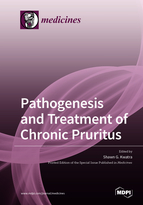Pathogenesis and Treatment of Chronic Pruritus
A special issue of Medicines (ISSN 2305-6320).
Deadline for manuscript submissions: closed (31 January 2020) | Viewed by 80894
Special Issue Editor
Special Issue Information
Dear Colleagues,
Chronic pruritus, defined as an itch persisting for more than six weeks, dramatically reduces quality of life. Chronic itch is associated with a variety of dermatologic, systemic, neurological, and psychological underlying etiologies. This Special Issue will compile original research and review articles on the pathogenesis and treatment of chronic pruritus. Manuscripts should deal with but are not limited to the list of keywords below:
- Chronic pruritus
- Itch
- Refractory pruritus
- Prurigo nodularis
- Atopic dermatitis
- Idiopathic chronic pruritus
Dr. Shawn G. Kwatra
Guest Editor
Manuscript Submission Information
Manuscripts should be submitted online at www.mdpi.com by registering and logging in to this website. Once you are registered, click here to go to the submission form. Manuscripts can be submitted until the deadline. All submissions that pass pre-check are peer-reviewed. Accepted papers will be published continuously in the journal (as soon as accepted) and will be listed together on the special issue website. Research articles, review articles as well as short communications are invited. For planned papers, a title and short abstract (about 100 words) can be sent to the Editorial Office for announcement on this website.
Submitted manuscripts should not have been published previously, nor be under consideration for publication elsewhere (except conference proceedings papers). All manuscripts are thoroughly refereed through a single-blind peer-review process. A guide for authors and other relevant information for submission of manuscripts is available on the Instructions for Authors page. Medicines is an international peer-reviewed open access monthly journal published by MDPI.
Please visit the Instructions for Authors page before submitting a manuscript. The Article Processing Charge (APC) for publication in this open access journal is 1400 CHF (Swiss Francs). Submitted papers should be well formatted and use good English. Authors may use MDPI's English editing service prior to publication or during author revisions.
Keywords
- chronic pruritus
- itch
- refractory pruritus
- prurigo nodularis
- atopic dermatitis
- idiopathic chronic pruritus





